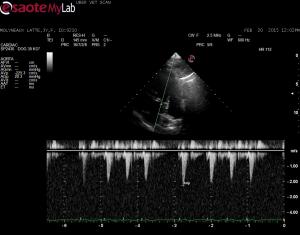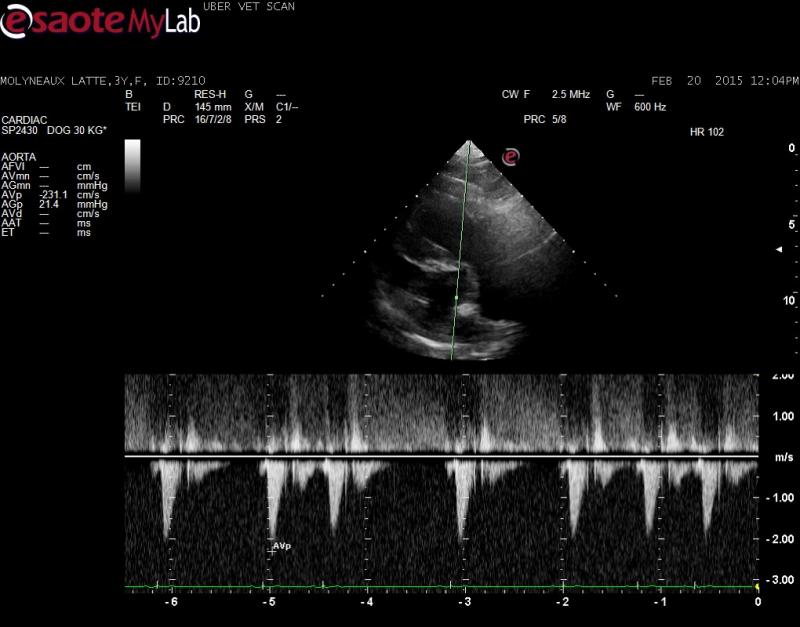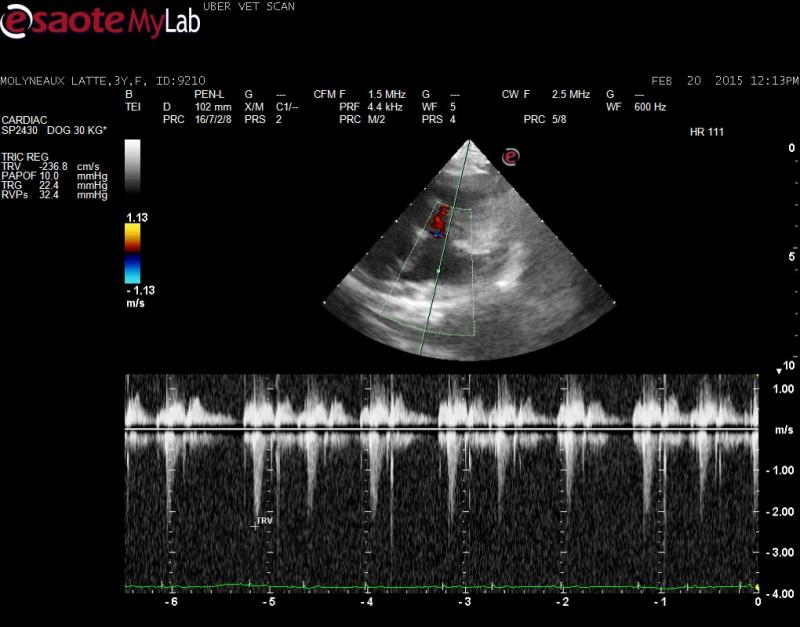– 3 yr old FS Lab Retriever presented for echo due to concern of bradycardia and left sided grade 1-2 systolic heart murmur
– history of left divisional intrahepatic shunt repaired at MSU via percutaneous transjugular coil embolization in 2012
– currently on PPA for urinary incontinence, Hepatosupport, herbs from TCM veterinarian
– recent bloodwork, thyroid panel and ACTH stim wnl
– Cardiopet ECG run day of echo showed sinus arrythmia only
– 3 yr old FS Lab Retriever presented for echo due to concern of bradycardia and left sided grade 1-2 systolic heart murmur
– history of left divisional intrahepatic shunt repaired at MSU via percutaneous transjugular coil embolization in 2012
– currently on PPA for urinary incontinence, Hepatosupport, herbs from TCM veterinarian
– recent bloodwork, thyroid panel and ACTH stim wnl
– Cardiopet ECG run day of echo showed sinus arrythmia only
Ehco: mild-moderate AI, no LAE, trace TR (flow underestimated on CW), no MR, pul Vmax wnl, chambers and valves look grossly normal to me; checked aorta flow several times and no evidence of aortic stenosis (nor gross features of it) (I am using <2.5 as a cut-off)
I have recommended a BP check and to scan again in 6-12 months. I am not concerned about the AI at this time as the heart appears to be well compensated, but I am curious to what may the cause of the AI?
Also, what is the cause of the systolic murmur? Could it be the TR? Physiologic? The murmur is new and was not detected when the shunt was repaired in the past at MSU.




14 responses to “Cause of AI?”
I am certainly no
I am certainly no cardiologist- but I am willing to give my 2 cents (as always).
I wonder if there is not some form of stenosis or at least some morphological change in the valves that is not functioning correctly i.e. the posterior semi-lunar cusp. That appears to me where the insufficiency is occuring. There also appears to be dilation of the aorta.
I would check the blood pressure on this dog.
OK- lets wait for the experts to weigh in.
I am certainly no
I am certainly no cardiologist- but I am willing to give my 2 cents (as always).
I wonder if there is not some form of stenosis or at least some morphological change in the valves that is not functioning correctly i.e. the posterior semi-lunar cusp. That appears to me where the insufficiency is occuring. There also appears to be dilation of the aorta.
I would check the blood pressure on this dog.
OK- lets wait for the experts to weigh in.
Thsi may be a minor form fo
Thsi may be a minor form fo SAS as the lvot velocity is high normal and the AI fits with that. Otherwise consider rickettsial disease and occult endocarditis or past sequleae from such. Not a clinical player right now though. A minor sas may have originally a grade 1 murmur missed on exam and uisually a velocity around 2m/sec will be auscoltable.
Given the shunt history often mionor concurrent congenital disease will be present in other organs.
Thsi may be a minor form fo
Thsi may be a minor form fo SAS as the lvot velocity is high normal and the AI fits with that. Otherwise consider rickettsial disease and occult endocarditis or past sequleae from such. Not a clinical player right now though. A minor sas may have originally a grade 1 murmur missed on exam and uisually a velocity around 2m/sec will be auscoltable.
Given the shunt history often mionor concurrent congenital disease will be present in other organs.
Thanks Eric
A mild SAS would
Thanks Eric
A mild SAS would be good news for this patient!
Thanks Eric
A mild SAS would
Thanks Eric
A mild SAS would be good news for this patient!
Hi
This is certainly mild
Hi
This is certainly mild aortic stenosis.
The most common causes of aortic regurg are:
The AS is mild, as is the AI. No therapy, just recheck.
Maybe check blood pressure and search for end organ damage since the aortic bulb appears to be a little wide.
Peter
Hi
This is certainly mild
Hi
This is certainly mild aortic stenosis.
The most common causes of aortic regurg are:
The AS is mild, as is the AI. No therapy, just recheck.
Maybe check blood pressure and search for end organ damage since the aortic bulb appears to be a little wide.
Peter
Thanks Peter. I was usuing
Thanks Peter. I was usuing <2.5 m/s as my cut off. What number should I be using instead to make the call of mild SAS?
Thanks Peter. I was usuing
Thanks Peter. I was usuing <2.5 m/s as my cut off. What number should I be using instead to make the call of mild SAS?
Hi,Depends in breed
Greyzone
Hi,Depends in breed
Greyzone ist usually 2-2.25 m/s some breeds 1,8-2,25 m/s, Boxer 2-2,4 m/s, if more its AS.
best regards!
peter
Hi,Depends in breed
Greyzone
Hi,Depends in breed
Greyzone ist usually 2-2.25 m/s some breeds 1,8-2,25 m/s, Boxer 2-2,4 m/s, if more its AS.
best regards!
peter
Very good to know. Thank-you
Very good to know. Thank-you Peter
Very good to know. Thank-you
Very good to know. Thank-you Peter